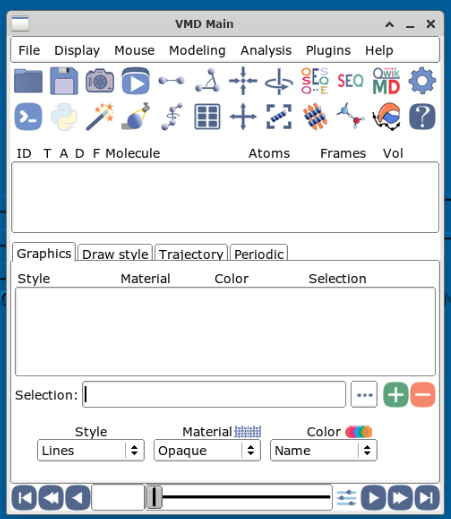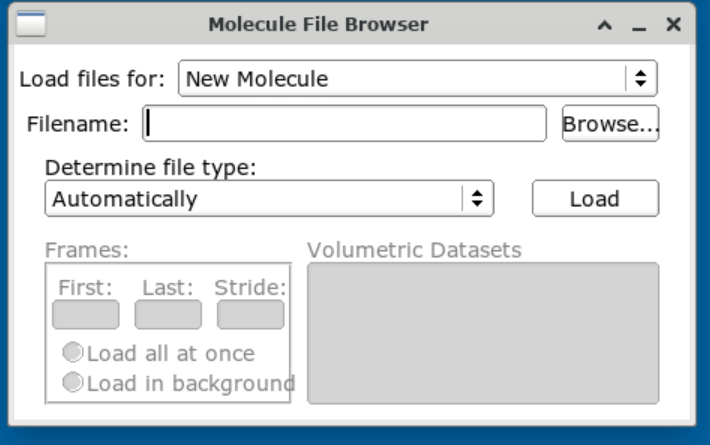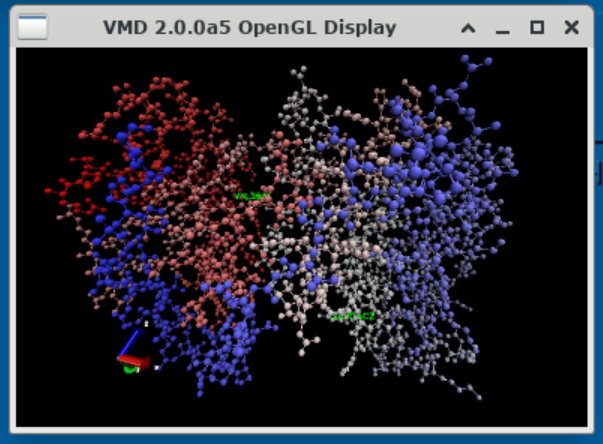



VMD is a molecular visualization program for displaying, animating, and analyzing large biomolecular systems using 3-D graphics and built-in scripting. It has powerful and comprehensive filtering and configuration capabilities. It is especially well-suited for analyzing NAMD results.
VMD is a graphics program, and therefore you need a graphics connection to Biowulf. We recommend using Biowulf's Open OnDemand Interface (Found here). Once you have logged in, launch a graphical session to open VMD within your browser.
Please do not run VMD on the login node, which is shared by many users. Instead, start an interactive session and run the program. If you expect to be running calculations with VMD, you may want to request more than the default 2 CPUs. In that case, use the flag --cpus-per-task=# in your sinteractive command.
Sample VMD session: (user input in bold)
biowulf% sinteractive --cpus-per-task=4
salloc.exe: Pending job allocation 13212187
salloc.exe: job 13212187 queued and waiting for resources
salloc.exe: job 13212187 has been allocated resources
salloc.exe: Granted job allocation 13212187
salloc.exe: Waiting for resource configuration
salloc.exe: Nodes cn0851 are ready for job
[user@cn0851 ~]$ module load vmd
[+] Loading netpbm 10.86 on cn0851
[+] Loading VMD v 2.0.0a5 ...
Using 2 CPUS
[user@cn0851 ~]$ vmd
Info) VMD for LINUXAMD64, version 2.0.0a5 (March 13, 2025)
Info) http://www.ks.uiuc.edu/Research/vmd/
Info) Email questions and bug reports to vmd@ks.uiuc.edu
Info) Please include this reference in published work using VMD:
Info) Humphrey, W., Dalke, A. and Schulten, K., `VMD - Visual
Info) Molecular Dynamics', J. Molec. Graphics 1996, 14.1, 33-38.
Info) -------------------------------------------------------------
Info) Multithreading available, 4 CPUs.
Info) CPU features: SSE2 SSE4.1 AVX AVX2 FMA F16 HT
Info) Free system memory: 231GB (91%)
Info) No CUDA accelerator devices available.
Info) OpenGL renderer: llvmpipe (LLVM 14.0.6, 256 bits)
Info) Features: STENCIL MSAA(4) MDE CVA MTX NPOT PP PS GLSL(OVFS)
Info) Full GLSL rendering mode is available.
Info) Textures: 2-D (16384x16384), 3-D (512x512x512), Multitexture (8)
OpenGLDisplayDevice) Creating OptiX RTRT context...
OptiXRenderer) Error setting RT_GLOBAL_ATTRIBUTE_ENABLE_RTX!!!
ERROR) OptiXRenderer) ERROR: Failed to load OptiX library (OptiXRenderer.C:1045
ERROR) OptiXRenderer) Failed to create OptiX rendering context
OpenGLDisplayDevice) OptiX RTRT context created.
Info) Dynamically loaded 2 plugins in directory:
Info) /usr/local/apps/vmd/2.0.0a5/lib/vmd/plugins/LINUXAMD64/molfile
At this point you should see two VMD windows appear. VMD is menu-driven, so now you can use the VMD File menu to load a PDB or traajectory file.



There are two plugins available for VMD, Molcontroller and RIP-MD.
To use these plugins, you will need to add the following lines to your ~/.vmdrc file:
lappend auto_path /usr/local/apps/vmd/Molcontroller/molcontrol1.0/ vmd_install_extension molcontrol molcontroller_tk "Modeling/Molcontrol" lappend auto_path /usr/local/apps/vmd/RIP-MD/ vmd_install_extension ripmd ripmd_tk "Analysis/RIP-MD"
The Molcontroller plugin appears in the VMD Main panel under Extensions --> Modeling --> Molcontrol.
RIP-MD appears in the VMD Main panel under Extensions --> Analysis --> RIP-MD.For additional plugins, please contact staff@hpc.nih.gov.